Once inland, everything changes. Snow-capped mountains provide a backdrop with Mount Misti (a volcanic peak) at 19,101’ (5,822 m) visible from the city. Streets are cleaner and architecture interesting , dominated here by the Spanish influence. Read on for insights about Spanish colonialism in South America, Pizzaro, the ‘ethics’ of the conquistadores, the life of rich nuns in the late 1500s, and other interesting facts about Arequipa, a fascinating city.
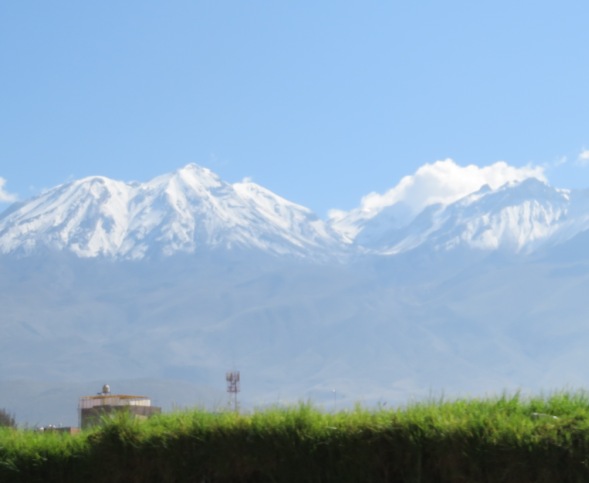
Mt. Misti as we were leaving Arequipa.
Because Arequipa is so colonial, at least in architecture, this is a good time to discuss the Spanish take over of the Inca empire including the territory that became modern-day Peru. Pizzaro’s conquest and the resulting colonial period has the usual horror stories of colonialism, but with some odd twists . Although I will be writing about the Inca and pre-Inca civilizations later because I am following our route rather than historical chronology, a little background is necessary here. In 1532 Atahualpa had just emerged as victor over his half-brother Huascar in an Incan civil war. As the supreme leader now over some 12 million people, with a large, successful military, an established political, cultural, and communication system, Atahualpa felt no concern about a bedraggled group of Spanish explorers requesting an audience.
Pizzaro is an interesting historical figure. Born around 1476, the illegitimate son of a poor farmer, who, nevertheless, had the title of Captain. Pizzaro was not educated and never learned to read or write. He was adventurous, however, and willing to take risks. He became a soldier and first went to Hispaniola, a Spanish colony in the “New World” (now Haiti and the Dominican Republic). Later he joined a conquistador exploring what is now Columbia and with Balboa “discovered” the Pacific Ocean. Ironically Pizzaro later arrested Balboa under orders of the conquistador with whom Pizzaro was serving. As you will see these conquistadors had a lot of in-fighting going on. Attracted by stories of Inca wealth, other conquistadors were interested in exploring further south. Pizzaro joined two such expeditions, the last one going as far as Peru where they obtained some Inca artifacts. Pizzaro hightailed it back to Panama with dreams of vast riches, but the Spanish governor refused to fund his plan, so Pizzaro sailed for Spain and gained permission from Emperor Charles V, who needed all those riches to fund his European wars.
Returning to Panama in 1530, Pizzaro started for Peru in 1531 and by November of 1532, he and his small army reached Cajamarca, where Atahualpa was basking in his victory. Pizzaro arranged a meeting with Emperor Atahualpa, but set up a hidden ambush. When Pizzaro insisted the Emperor accept the rule of Charles V and Catholicism, Atahualpa threw down in disgust the bible handed him and refused. He and his unarmed troops were immediately attacked with guns and cavalry, weapons and battle techniques the Inca had no knowledge of. It was a mass slaughter by the Spanish. Taking Atahualpa hostage, Pizzaro demanded a roomful of gold and silver for his release. Immediately the Inca runners set out with that message and soon there was indeed a room full of riches in Cajamarca. But, of course, Pizzaro reneged on Atahualpa’s release and had him killed instead. Subduing the rest of Peru didn’t take too long, and Pizzaro established Lima as the seat of colonial power. By 1541, Pizzaro was dead, assassinated by other power-and-riches-hungry conquistadores. What lust for gold can do!
Encomienda was the legal system by which conquistadores gained land of their own in the Spanish colonies. Ironically, it was originally meant to allow the strong (the conquistadores) to protect the weak (the indigenous people) for a price. It quickly evolved into a land grab by the conquistadores and a serfdom/slavery system of the local people.

The Plaza de Armas.
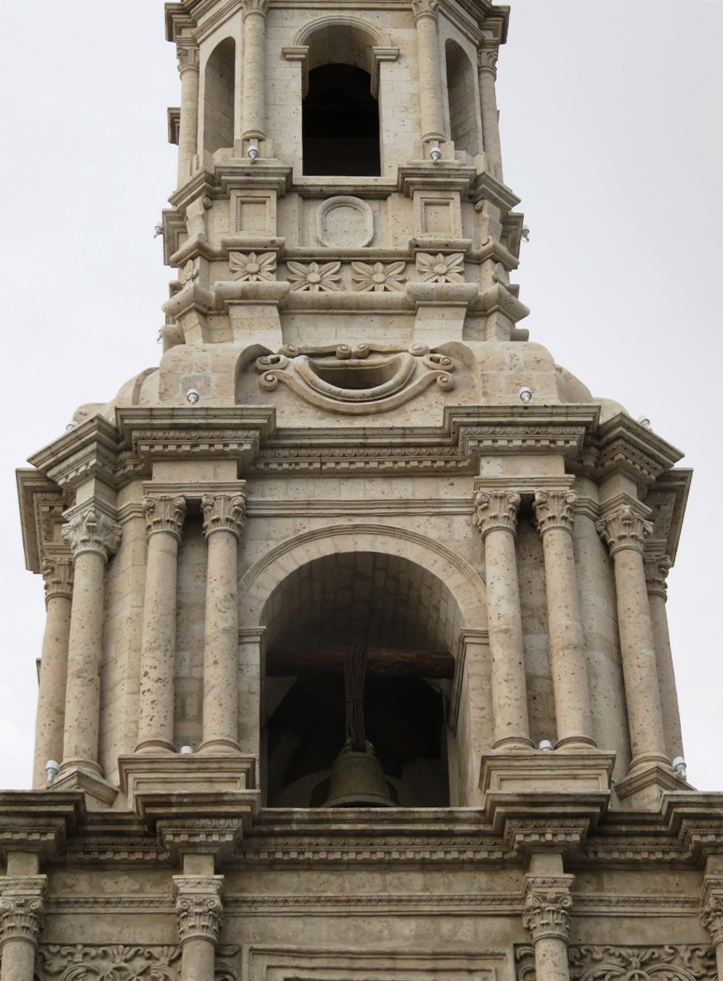
Detail from the Cathedral.
In the meantime, the Church with all its trappings and hierarchy of priests and nuns, etc., followed the conquistadores quickly to gain souls and feed its thirst for wealth. (Bear in mind, we’re talking about the late 1500s, not today.) This leads me to describe one of my favorite places in Arequipa: the Monasterio de Santa Catalina, a convent founded in 1579. It’s called “a city within a city,” and the women who joined this nunnery were cloistered, did not see family, friends, or outsiders again, and took a vow of silence, at least for their first four years. Part of the convent has been opened to the public and is separated from the part used by the nuns today. It’s a welcome respite from the bustle of the central Plaza de Armas (along with the cathedral, a “requirement” in every Peruvian city).
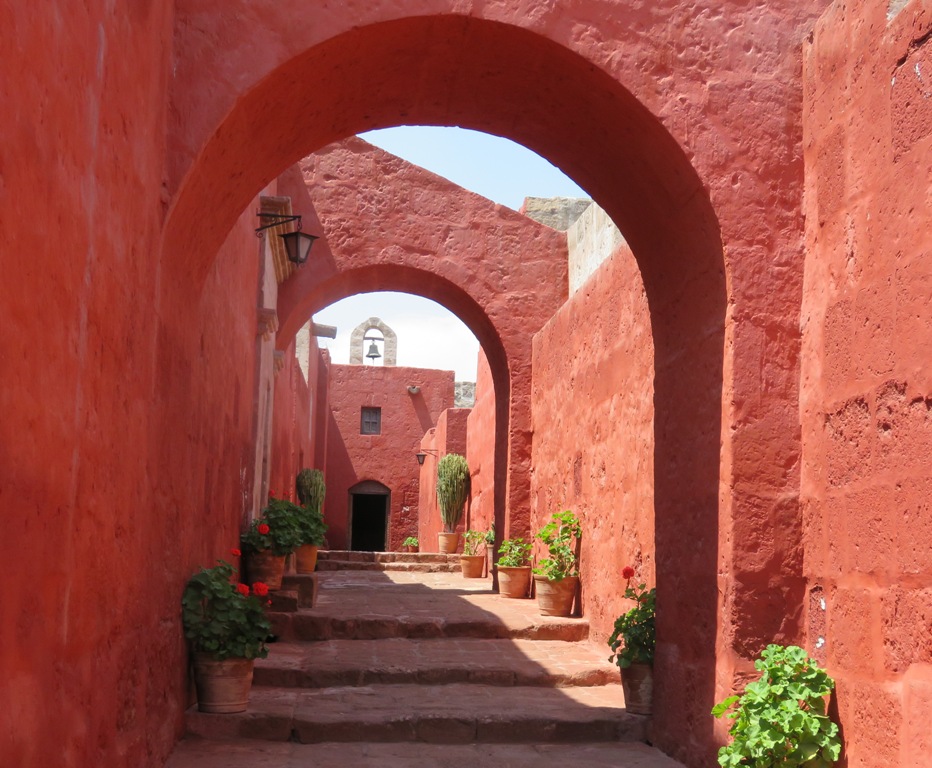
One of the walking streets within the convent.
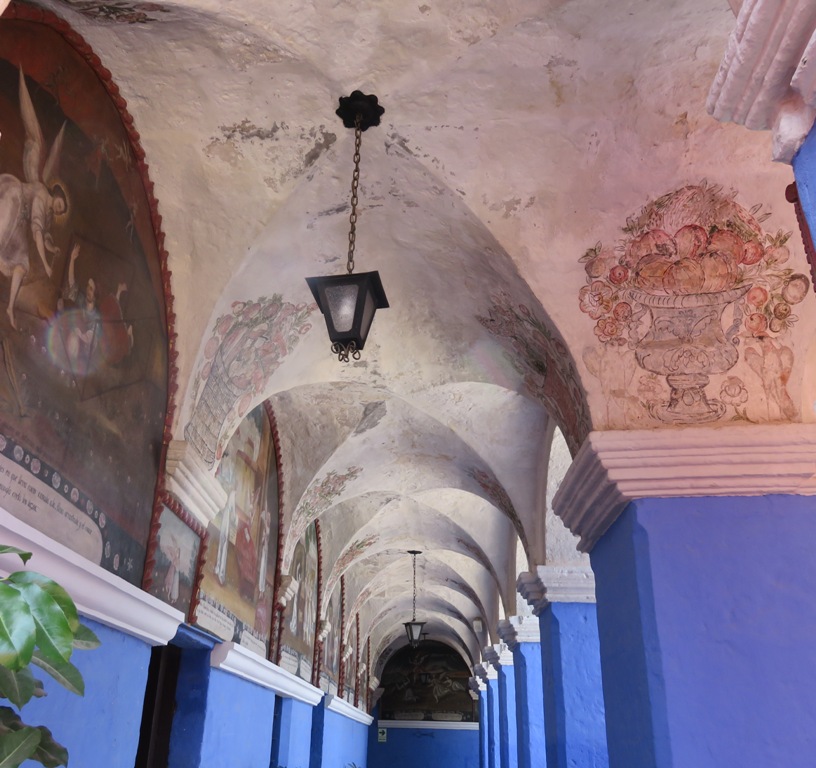
Architectural and artwork detail and example of the color used in the convent.
Interestingly in 1632 one nun sold her cell to another nun for 50 pesos. I’m not sure where the seller then lived. Built of stone, each cell had a cot, a fireplace for cooking, the religious artifacts necessary for practicing their faith, and some had a chair, a table, artwork, a chest or cupboard. There was a central kitchen, bath, chapel, and laundry. Originally the nuns came from wealthy families, who had to pay an annual dowry for their daughters to be there. These early nuns brought a retinue of servants/slaves with them along with artwork, china, and tapestries. In fact there were many more slaves and servants than nuns. This was changed when a Sister from Europe was sent by the Pope in 1871 to straighten out the place. She sent the riches back to the church in Rome and freed the slaves.
 A nun’s cell.
A nun’s cell.

Some of the items belonging to the early nuns.
Peruvian Spanish colonial architecture is primarily Baroque with indigenous influences. Spanish architecture itself sprang from the Moorish influence, not a fact the Spanish always like to acknowledge. The Monasterio de Santa Catalina is made of sillar, a white volcanic stone often used throughout specific areas of Peru, where it is quarried. In striking contrast to the white are brilliant sunlit walls of red, orange, and blue. All interspersed with gardens, cloisters, and walkways. The overall feeling is one of peace and serenity, a space where one wants to remain.
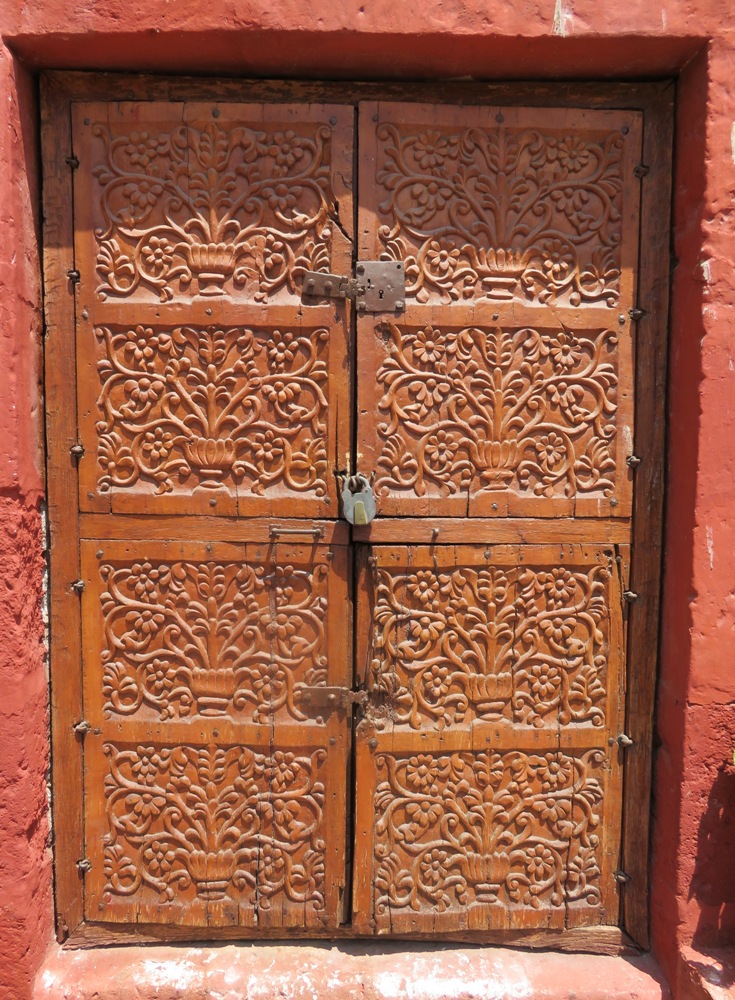
A door in the convent that is clearly Moorish in its design.
Like any city, there are sections of Arequipa that are run-down. There is certainly poverty in Peru, but there is a substantial middle class, unlike some countries where the difference between the haves and have-nots is extreme. Peru is not a third-world country.
Arequipa is at 7,661’ (2,335 m) and that will lead me to my next blog about the Alto Plano and Colca Canyon, considerably higher, in a few days.
